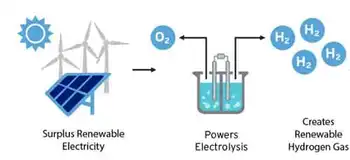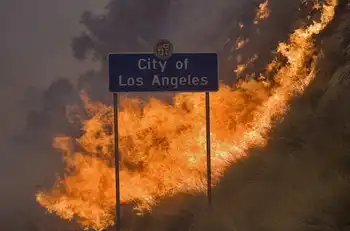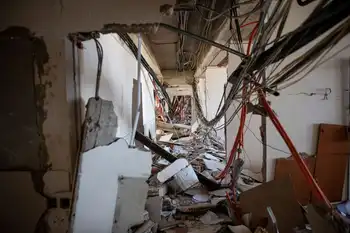Origin of Blackout Remains A Mystery
Buffalo -- - The prime minister of Canada blamed a lightning strike in Niagara County.The governor of New York pointed to a power transmission problem from Canada. And local utility officials simply shrugged, said they didn't know the cause, and concentrated on restoring electricity to hundreds of thousands of Western New Yorkers.
Whatever the origin, still undetermined this morning, local officials say the power outage that included much of suburban Buffalo and surrounding areas throughout Western New York is likely the most serious in the century-old history of regional electrical service.
"The ice storm of two years ago was a big one," said Stephen F. Brady, spokesman for Niagara Mohawk Power Corp. "But certainly regionally, this is probably the biggest since the blackout of '65."
How big was it?
Niagara Mohawk Power Corp. President William F. Edwards said during a late-night conference call that 1.25 million of the company's 1.5 million customers across upstate were without power at the peak of the event. But shortly before midnight, that number was drastically reduced to about 300,000.
Edwards warned, however, that as power demands increased this morning, more problems could develop. As local customers were reported to be slowly coming back on line, officials of Niagara Mohawk, New York State Electric and Gas and the New York Independent System Operator in suburban Albany all remained stumped as to the cause even if Canadian Prime Minister Jean Chretien's spokesman pointed to Niagara County and a power plant damaged by lightning.
But National Weather Service officials said the closest lightning strike Thursday occurred near Chicago, and Gov. George E. Pataki's office said attention was focusing on the Canadian transmission problem. Meanwhile, the New York Power Authority denied that any Niagara-region problem was responsible or that a lightning strike had occurred.
And Pataki cast strong doubt on the Canadian version by telling CNN's Larry King that the report was "untrue."
"In fact, our hydro plant worked well out there," Pataki said, "and that's one of the reasons we had power."
Indeed, Brady said all indications pointed to the Power Authority at Lewiston -- where lights burned brightly all night long -- as the only facility generating and transmitting electricity in all of New York.
Niagara Mohawk's Edwards strongly dismissed accusations pointed at the Niagara Mohawk grid. "No data we've seen supports the notion it was on the Niagara Mohawk system," he said, adding that a "nationally led effort" will be launched to determine the cause.
He also challenged any speculation that the power failure stemmed from outmoded equipment or that the Niagara Mohawk system was the first to fail.
"It's way too early to speculate on what factors led to this particular outage," he said.
While he could not guarantee that the power failure resulted from sabotage, he said the system "behaved" in a normal fashion consistent with standard power outages.
"We believe we have an electrical system in the U.S. of very high reliability," he said. "It's not 100 percent, and events like this show that."
The most immediate problem facing local power officials was preventing an even more massive shutdown. Brady said power managers were facing a delicate balancing act as electricity was restored to some customers. If too many customers came on line at the same time, he said, more blackouts could occur.
"As the system comes back up, balancing the electrical network is literally a second-by-second proposition," he said. "We have to coordinate with the ISO (the Independent System Operator in Albany County that coordinates the state's power grid) to keep that balance as the major population centers come on line.
"If you pick up a thousand customers in East Hoboken," he added, "you have to be careful not to knock off another thousand somewhere else."
The ISO's Kate Doyle said the Guilderland command center acted as "the maestro facing the orchestra" in integrating power back into the statewide grid. She compared it to powering up a house after blowing a fuse.
"If you turn on all the lights again at the same time, you blow a fuse," she said. "Same here. If you turn on everything at once, you have even more of a problem."
Utility officials advised their customers returning to the system to take a number of precautions. Brady said "sensitive" electrical appliances such as computers and VCRs should be turned off to protect against unlikely power surges. He also asked that customers limit their consumption once power is restored.
Still, there was no question all of New York State was experiencing an unprecedented loss of electricity. Pataki estimated half the state was dark, while Brady said much of Western New York was also without power -- especially in Amherst, the Tonawandas and Niagara County.
The ISO's Web site reported a "real-time load" of 5,641 megawatts of electricity being transmitted throughout New York late Thursday. The normal level is about 28,000 megawatts, according to ISO's Doyle.
The one bright spot, literally and figuratively, was the City of Buffalo. Brady said the largest population center in the NiMo system experienced only a few scattered outages.
That randomness -- the lack of any discernible pattern -- may have proved the emergency's most perplexing aspect. One block in Kenmore was reported humming with air conditioners and television sets, while residents of an adjacent block kept track of the emergency on portable radios and lighted their homes by candlelight. While the Walden Galleria in Cheektowaga shut down when the lights failed around 4 p.m., the Wegmans supermarket across Walden Avenue remained fully operational.
And while subway riders in New York City found themselves trapped in sweltering trains, Metro Rail ferried thousands of Buffalo commuters home under Main Street without incident.
Brady explained that what neighborhoods stayed lighted and what neighborhoods failed was due to how the system reacted to the chain-reaction shutdown, and not by any "conscious decision" by power grid managers.
The emergency was considered the most serious since the Great Northeast Blackout of Nov. 9, 1965. At 5:27 p.m. on that day, most of New York State, New York City, much of New England and Ontario were suddenly without electricity -- leaving 80,000 square miles and 30 million people in the dark. By 6:58 a.m. the next day, power was restored to all of New York City and to the rest of the region shortly afterward.
While speculation for Thursday's blackout centered on Niagara Falls, N.Y., the actual cause of the 1965 incident was traced to the Sir Adam Beck Station No. 2 in Niagara Falls, Ont. Six days after the failure, Federal Power Commission investigators traced the problem to a single faulty relay, which triggered a series of overloads that overtook main trunk lines and caused power plants to shut down automatically.
Related News

What can we expect from clean hydrogen in Canada
TORONTO - As the world races to find effective climate solutions, hydrogen is earning buzz as a potentially low-emitting alternative fuel source.
The promise of hydrogen as a clean fuel source is nothing new — as far back as the 1970s hydrogen was being promised as a "potential pollution-free fuel for our cars."
While hydrogen hasn't yet taken off as the fuel of the future — a 2023 report from McKinsey & Company and the Hydrogen Council estimates that there is a grand total of eight hydrogen vehicle fuelling stations in Canada — many still hope that will change.
The hope is hydrogen…




